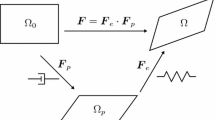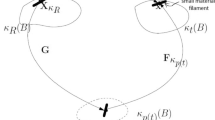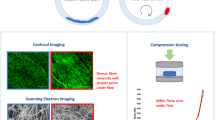Abstract
Thrombi are formed at the end of a series of complex biochemical processes. There are various types of thrombi, and their rheological properties change depending on the conditions during clot formation. In this paper, a model for a particular type of clot, formed from human plasma, is proposed within a thermodynamic framework that recognizes that viscoelastic fluids possess multiple natural configurations.
Similar content being viewed by others
References
Anand M., Rajagopal K.R. (2004). A shear-thinning viscoelastic fluid model for describing the flow of blood. Int. J. Cardiovasc. Med. Sci. 4(2):59–68
Anand M., Rajagopal K., Rajagopal K.R. (2003). A model incorporating some of the mechanical and biochemical factors underlying clot formation and dissolution in flowing blood. J. Theor. Med. 5(3-4):183–218
Badimon L., Chesebro J.H., Badimon J.J. (1992). Thrombus formation on ruptured atherosclerotic plaques and rethrombosis on evolving thrombi. Circulation 86(6, Suppl. S):74–85
Bale M.D., Ferry J.D. (1988). Shear enhancement of elastic modulus in fine fibrin clots. Thromb. Res. 52(6):565–572
Blömback B., Okada M. (1982). Fibrin gel structure and clotting time. Thromb. Res. 25(1–2):51–70
Bluestein D., Niu L., Schoephoerster R.T., Dewanjee M.K. (1997). Fluid mechanics of arterial stenosis: relationship to the development of mural thrombus. Ann. Biomed. Eng. 25(2):344–356
Cammerer U., Dietrich W., Rampf T., Braun S.L., Richter J.A. (2003). The predictive value of modified computerized thromboelastography and platelet function analysis for postoperative blood loss in routine cardiac surgery. Anesthetics Analgesics 96(1):51–57
Caro C.G., Pedley T.J., Schroter R.C., Seed W.A. (1978). The Mechanics of the Circulation. Oxford University Press, Oxford
Carr M.E., Hermans J. (1978). Size and density of fibrin fibers from turbidity. Macromolecules 11(1):46–50
Dascombe W.H., Dumanian G., Hong C., Heil B.V., Labadie K., Hessel B., Blömback B., Johnson P.C. (1997). Application of thrombin based fibrin glue and non-thrombin based batroxobin glue on intact human blood vessels: evidence for transmural thrombin activity. Thromb. Haemost. 78(2):947–951
Diamond S.L. (1999). Engineering design of optimal strategies for blood clot dissolution. Annu. Rev. Biomed. Eng. 1, 427–461
Ferry J.D., Morrison P.R. (1947). Preparation and properties of serum and plasma proteins. viii. The conversion of human fibrinogen to fibrin under various conditions. J. Am. Chem. Soc. 69, 388–400
Fogelson A.L. (1992). Continuum models of platelet aggregation: formulation and mechanical properties. SIAM J. Appl. Math. 52(4):1089–1110
Fogelson A.L., Guy R.D. (2004). Platelet-wall interactions in continuum models of platelet thrombosis: formulation and numerical solution. Math. Med. Biol. 21(4):293–334
Fukada E., Kaibara M. (1976). Rheological measurements of fibrin gels during clotting. Thromb. Res. 8(Suppl. II):49–58
Gerth C., Roberts W.W., Ferry J.D. (1974). Rheology of fibrin clots. II. Linear viscoelastic behavior in shear creep. Biophys. Chem. 2(3):208–217
Glover C.J., McIntire L.V., Brown C.H., Natelson E.A. (1975a). Dynamic coagulation studies: influence of normal and abnormal platelets on clot structure formation. Thromb. Res. 7(1):185–198
Glover C.J., McIntire L.V., Brown C.H., Natelson E.A. (1975b). Rheological properties of fibrin clots. Effects of fibrinogen concentration, factor XIII deficiency, and factor XIII inhibition. J. Lab. Clin. Med. 86(4):644–656
Hartert H.H. (1982). The proper phase of coagulation. Its physical differentiation by resonance-thrombography and thromboelastography. Clin. Hemorheol. 2(1-2):51–69
Jackson M.R., Alving B.M. (1999). Fibrin sealant in preclinical and clinical studies. Curr. Opin. Hematol. 6(6):415–419
Jacobs M.L., Pourmoghadam K.K., Geary E.M., Reyes A.T., Madan N., McGrath L.B., Moore J.W. (2002). Fontan’s operation: is aspirin enough? Is coumadin too much? Ann. Thorac. Surg. 73(1):64–68
Janmey P.A., Amis E.J., Ferry J.D. (1983). Rheology of fibrin clots. VI. Stress relaxation, creep, and differential dynamic modulus of fine clots in large shearing deformations. J. Rheol. 27(2):135–153
Kaibara M. (1994). Rheological studies on blood coagulation and network formation of fibrin. Polym. Gels. Netw. 2(1):1–28
Kaibara M. (1996). Rheology of blood coagulation. Biorheology 33(2):101–117
Kaibara M., Fukada E., Sakaoku K. (1981). Rheological studies on network structure of fibrin clots under various conditions. Biorheology 18(1):23–35
de Korte C.L., Schaar J.A., Mastik F., Serruys P.W., van der Steen A.F. (2003). Intravascular elastography: from bench to bedside. J. Intervent. Cardiol. 16(3):253–259
Krishnan J.M., Rajagopal K.R. (2004). Thermodynamic framework for the constitutive modeling of asphalt concrete: theory and applications. J. Mater. Civ. Eng. 16(2):155–166
Kuharsky A.L., Fogelson A.L. (2001). Surface mediated control of blood coagulation: the role of binding site densities and platelet deposition. Biophys. J. 80(3):1050–1074
Lowe G.D.O. (1999). Rheological influences on thrombosis. Baillières Clin. Haematol. 12(3):435–449
MacFarlane R.G. (1964). The cascade model of blood coagulation and its role as an amplifier. Nature 202, 498–499
Morris R.J., Woodcock J.P. (2004). Evidence-based compression: prevention of stasis and deep vein thrombosis. Ann. Surg. 239(2):162–171
Nelb G.W., Gerth C., Ferry J.D., Lorand L. (1976). Rheology of fibrin clots. III. Shear creep and creep recovery of fine ligated and coarse unligated clots. Biophys. Chem. 5(3):377–387
Nelb G.W., Kamykowski G.W., Ferry J.D. (1981). Rheology of fibrin clots. V. Shear modulus, creep, and creep recovery of fine unligated clots. Biophys. Chem. 13(1):15–23
Pifarre R. (1998). Thrombosis and cardiovascular disease. Med. Clin. North. Am. 82(3):511–522
Pipkin A.C. (1972). Lectures on Viscoelasticity Theory. Springer, Berlin Heidelberg New York
Prasad S.C., Rao I.J., Rajagopal K.R. (2005). A continuum model for the creep of single crystal nickel-base super alloys. Acta. Materialia 53(3):669–679
Rajagopal, K.R.: Multiple natural configurations in continuum mechanics. In: Reports of the Institute for Computational and Applied Mechanics. University of Pittsburgh, Pittsburgh (1995)
Rajagopal K.R., Srinivasa A.R. (2000). A thermodynamic framework for rate type fluid models. J. Non-Newtonian Fluid Mech. 88(3):207–227
Rajagopal K.R., Tao L. (2002). Modeling of the microwave drying process of aqueous dielectrics. ZAMP 53(6):923–948
Riha P., Liao F., Stoltz J.F. (1997). Effect of fibrin polymerization on flow properties of coagulating blood. J. Biol. Phys. 23(2):121–128
Riha P., Wang X., Liao R., Stoltz J.F. (1999). Elasticity and fracture strain of whole blood clots. Clin. Hemorheol. Microcirc. 21(1):45–49
Roberts W.W., Lorand L., Mockros L.F. (1973). Viscoelastic properties of fibrin clots. Biorheology 10(1):29–42
Sakharov D.V., Rijken D.C. (2000). The effect of flow on lysis of plasma clots in a plasma environment. Thromb. Haemost. 83(3):469–474
Schaar J.A., de Korte C.L., Mastik F., Baldewsing R., Regar E., de Feyter P., Slager C.J., van der Steen A.F., Serruys P.W. (2003). Intravascular palpography for high-risk vulnerable plaque assessment. Herz 28(6):488–495
Shortland A.P., Jarvis J.C., Salmons S. (2003). Haemodynamic considerations in the design of a skeletal muscle ventricle. Med. Biol. Eng. Comput. 41(5):529–535
Spiess B.D. (1995). Thromboelastography and cardiopulmonary bypass. Semin. Thromb. Haemost. 21(Suppl. 4):27–33
Strony, J., Beaudoin, A., Brands, D., Adelman, B.: Analysis of shear stress and hemodynamic factors in a model of coronary artery stenosis and thrombosis. Am. J. Physiol. 265(5, Pt. 2), H1787–H1796 (1993)s
Sukavaneshvar S., Rosa G.M., Solen K.A. (2000). Enhancement of stent-induced thromboembolism by residual stenoses: contribution of hemodynamics. Ann. Biomed. Eng. 28(2):182–193
Tang D., Yang C., Kobayashi S., Ku D.N. (2001). Steady flow and wall compression in stenotic arteries: a three-dimensional thick-wall model with fluid–wall interactions. J. Biomech. Eng. 123(6):548–557
Thubrikar M.J., Robicsek F., Labrosse M., Chervenkoff V., Fowler B.L. (2003). Effect of thrombus on abdominal aortic aneurysm wall dilation and stress. J. Cardiovasc. Surg. (Torino) 44(1):67–77
Thurston G.B., Henderson N.M. (1993a). The kinetics of viscoelastic changes due to blood clot formation. In: Moldenaers P., Keunings R. (eds) Theoretical and Applied Rheology, Vol. 2. Elsevier, Amsterdam, pp. 741–743
Thurston G.B., Henderson N.M. (1993b). A new method for the analysis of blood and plasma coagulation. Biomed. Sci. Instrum. 29, 95–102
Thurston G.B., Henderson N.M. (1995). Impedance of a fibrin clot in a cylindrical tube – relation to clot permeability and viscoelasticity. Biorheology 32(5):503–520
Velada J.L., Hollingsbee D.A., Menzies A.R., Cornwell R., Dodd R.A. (2002). Reproducibility of the mechanical properties of vivostat system patient-derived fibrin sealant. Biomaterials 23(10):2249–2254
Wang D.H., Makaroun M.S., Webster M.W., Vorp D.A. (2001). Mechanical properties and microstructure of intraluminal thrombus from abdominal aortic aneurysm. J. Biomech. Eng. 123(6):536–539
Wang D.H., Makaroun M.S., Webster M.W., Vorp D.A. (2002). Effect of intraluminal thrombus on wall stress in patient-specific models of abdominal aortic aneurysm. J. Vasc. Surg. 36(3):598–604
Author information
Authors and Affiliations
Corresponding author
Additional information
Communicated by O.E. Jensen and J. Malek
Rights and permissions
About this article
Cite this article
Anand, M., Rajagopal, K. & Rajagopal, K.R. A viscoelastic fluid model for describing the mechanics of a coarse ligated plasma clot. Theor. Comput. Fluid Dyn. 20, 239–250 (2006). https://doi.org/10.1007/s00162-006-0019-9
Received:
Accepted:
Published:
Issue Date:
DOI: https://doi.org/10.1007/s00162-006-0019-9




